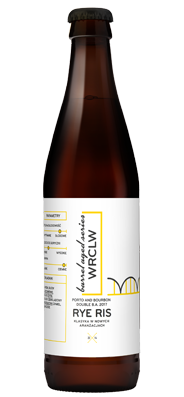Russian Imperial Stout is a historical dark beer style whose origins go back to the turn of the 18th and beginning of the 19th century by London-based breweries for thrill-seeking consumers. Clear malty tones – coffee, chocolate and caramel and velvety rye malts – bring to mind Belgian pralines. Ageing in Porto and Bourbon oakwood barrels gives the beer refined vanilla, coconut, dry dark fruit aromas enhanced with Porto and American whiskey tones.
Style
The origins of one of the world’s strongest beers – Russian Imperial Stout – date back to London at the turn of the 18th century, where breweries created this style for consumers looking for new high quality beers, specifically more intense and full-bodied beers. With time, this style became well appreciated in Europe and was exported to the entire continent including Sankt Petersburg. This is the reason why it was called Russian Imperial Stout; some argue that it happened for marketing reasons.
Malts/extract:
To produce such a high extract, it is necessary to use loads of malts. We have used a mix traditionally used to brew Imperial Stout i.e. the basic Pilsner malt, Munich to produce intense flavours, dark roasted caramel and dark malts: chocolate wheat and colouring malt filled with chocolate and coffee tones. Rye malt has given the beer a certain twist, which increases the beer’s stickiness, and produces an effect of stoutness associated with spicy and earthy nature of this ingredient.
Hops:
Traditional and continental hops have been used: Magnum to produce some bitterness to balance the hoppy maltiness; and Tettnanger to produce a herbal aroma that oxidizes in a wonderful way in strong, dark beers.
Ageing in Porto and Bourbon barrels:
The process of ageing beer in barrels is an incredible experience. First, during beer oxidization process, flavour and aroma balance, Porto, sherry and dried fruit flavours (prunes, raisins, cherries) come to light. Alcohol tones slightly fade away while wood releases:
- tannins – defined as the wood flavour that introduces specific astringency to balance beer
sweetness. - Caramels and so called Maillard reaction compounds that are released during barrel smoking
process (they are accountable for the unique colour of Bourbon) - Lignins finally transform into vanilins and gives the beer its characteristic vanilla flavours;
American oak produces a group of phenols which account for spicy aromas: cloves,
cinnamon, coconut and smoky tones.
Finally, as the beer matures in the barrel, which is not a tight container, water evaporates more quickly than other ingredients. This effect is known as the “angel’s share.”
Barrel-aged beers absorb the qualities of the alcohol previously stored in the barrels. Tawny Porto accounts for the beer’s slight acidity, deep aroma of red fruit: blackberries, cherries and raspberries, as well as spices such as cinnamon and cloves. Bourbon barrels produce intense vanilla aromas enriched with coconut andspice overtones.
Taking everything into consideration, the complexities and multiple layers of this beer style can be savoured in various temperatures. We recommend serving it in a slightly lower temperature of about 10°C and warming it up in your palms up to about 18°C.
- Styl: Russian Imperial Stout
- Parameters
- Extract: 23,0 %
- Alcohol: 10,2 %
- IBU: 62
- Ingredients:
- Malts: Pilsner; rye; caramel 400 EBC; Munich malt; wheat malt; chocolate; colouring malt
- Hops: bitter: Hallertau Magnum (DE), Aromatic: Tettnanger (DE)
- Yeasts: top-fermenting US-05
- Look: black with ruby highlights
- Aromas: vanilla; chocolate; coconut; cherry; blackberries; raspberries; prunes; cinnamon; cloves
- Mouthfeel:
- Full-bodied; velvety; lower saturation
- Bitter chocolate; dark fruit
- Bourbon, Porto sour, oakwood
- Serving temperature: 10-13 ⁰C
- Glass: Tulip, Sniffter
- Foodpairing:
Dishes: seasoned beef; venison in chocolate-blackberry sauce
Cheeses: maturing Gouda or Cheddar,
Dessert: dark truffles, chocolate cakes



